For more information:
Note that the latest stuff may not yet be indexed.
The Klezmer Shack directory of articles
No taxing music here
Byrd/Chevan / This is the Afro-Semitic Experience, 2002
Tim Sparks / At the Rebbe's Table, 2002
Yankele / L'Esprit du klezmer, 2001
Howard Leshaw / Bronx Volume II: Yiddish on the Edge, 2001
Klezmaniacs (MA) / Sveet like herring vit potatoes, 2001
Amsterdam Klezmer Band / Limonchiki, 2001
Alain Chekroun & Taouifik Bestandji / Chants des Synagogues du Maghreb, 2000
Mark Levy / Bin ikhmir a shnayderl (I'm a little Tailor), 1999
Roy Nathanson & Anthony Coleman / I could've been a drum, 1997
Rabson, Mimi / Music, 2002
For the rest of the country, today is the final deadline to submit tax returns. Here in Massachusetts, however, it is Patriots Day, or some such, and we set aside our tax forms until tomorrow so as to either run in the Boston Marathon or listen to klezmer. Those who have seen my svelt racing self can guess most easily which option I chose.
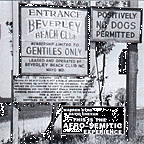 Byrd/Chevan / This is the Afro-Semitic Experience. Reckless DC Music, RMCD-1050. E-mail: dchevan@snet.net. Purchase from cdbaby.com.
Byrd/Chevan / This is the Afro-Semitic Experience. Reckless DC Music, RMCD-1050. E-mail: dchevan@snet.net. Purchase from cdbaby.com.
What infectious, wonderful jazz! Opening with an "Eliyahu Hanavi" that will get everyone bopping at your next Havdalah, and continuing with a more thoughtful, but still infectiously cheerful "Tashlikh," this new outing by David Chevan and Warren Byrd, this time accompanied by a larger band, is a delight. Byrd and Chevan have created an unusual, always listenable, and sometimes more profound space in recent years by reworking sacred song from both Black and Jewish traditions in jazz form. I've found the previous outings as a duo interesting, but not necessarily compelling. This album is compelling. The music isn't pushing the edges of jazz; rather, it is using jazz to bring out the commonality of spirituality in music from two traditions, and then some. The result is excellent, sometimes danceable, always listenable and warming music.
I rarely speak to the politics or good intentions of music, in part because I feel that didactic music rarely entertains. Music, and art in general, often benefit when they grounded by coherent, life-affirming spiritual or political knowledge, but that grounding is just the beginning of being able to express something worth (in the case of music) listening to. Having said that, hearing some wonderful Charles Mingus (okay, I'm especially a sucker for Mingus, well-played) and Abdullah Ibrahim, alongside an amazing "Sha Shtil", or even better, "Shir Leshalom" fused with a traditional African percussive piece, "Aalafiya," does something good for the soul. The album ending, "Waters of Babylon," with Stacy Phillips wonderful resonator guitar, is as quietly sublime as the opener is infectiously up-and-moving. This is definitely a grounded album, but one also backed up by a wonderful sense of swinging jazz. I like it a lot.
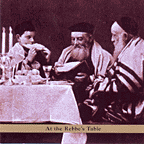 Tim Sparks / At the Rebbe's Table, 2002. Tzadik, TZ7160. www.tzadik.com
Tim Sparks / At the Rebbe's Table, 2002. Tzadik, TZ7160. www.tzadik.com
I have been a fan of Tim Sparks' playing for many years. On this, his third album for Tzadik, he is joined on guitar by Marc Ribot, as well as by Erik Friedlander on cello, and by Greg Cohen on bass and Cyro Baptista on percussion. As was the case on previous Tzadik releases, the intricate guitar work, transforming Jewish song from a wide variety of Jewish musical sources, is stunning and warm. From the opening "Returning from the river," based on the more traditional klezmer tune, "Fun tashlich," to Flory Jagoda's "Todos Hueron," to John Zorn's "Mahshav," to a graceful, jazzy "La Serena" (Sephardic, via Greece, and with a lovely cello solo) this album takes up where "Tanz" left off and leaves one with similar good, thoughtful feelings. At the same time, there is an American folk feel that also influences these arrangements. The opening chords to "Beautiful City," based on a Yemenite dance, could also open the best work of John Fahey (although the path taken is considerably different). For fans of Sparks' music, this album is excellent news and a delight. With luck, it will also introduce new listeners to a remarkable and lovely body of work.
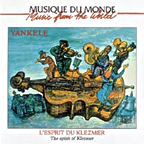 Yankele / L'Esprit du klezmer, 2001. Buda Records, 1983142. www.budamusique.com
Yankele / L'Esprit du klezmer, 2001. Buda Records, 1983142. www.budamusique.com
The French approach to klezmer has been a bit difficult for me. This may have to do with the possible fact that klezmer has no more place in French Jewish culture than it does in other Western European culture, and now is used to evoke nostalgia for a time and place that, in France, never were. For reasons I have never understood, the French klezmer I have heard has tended much more strongly towards the schmaltz. Even here, where the songs are played well, the repertoire tends not towards what one presumes is played at actual French Jewish weddings today, but towards that nostalgia mentioned earlier. Thus, after a couple of lively dance tunes, one gets "Dona, Dona," sung by a young child with an adult interrupting to speak (about a life that is gone? I have no significant French, and no English notes beyond superlatives about the band, from the band's promo material) during the verse, and then harmonizing sweetly as the child reprises the chorus. There is repeated use of a child's voice, including a child laughing in delight at the playing of one especially lively and fun piece.
As a nostalgia piece, this CD is well done. The music is very well-played. Some parts of it are excellent. But, even though the music is played with verve and skill, I am not able to escape the constant reminders that this is nostalgia or a period piece, not, apparently, a living tradition for those who play it. That makes the album less interesting, and less vital than I would have expected, given the level of playing.
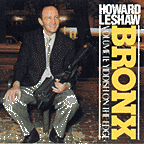 Howard Leshaw / Bronx Volume II: Yiddish on the Edge, 2001. Eifie Records 201. E-mail: jotas@earthlink.net. CD from cdbaby.com.
Howard Leshaw / Bronx Volume II: Yiddish on the Edge, 2001. Eifie Records 201. E-mail: jotas@earthlink.net. CD from cdbaby.com.
Howard Leshaw's new album evinces a very different form of nostalgia. Dedicated to the Bronx in which he grew up, the music is lush without being syrupy, full and expressive and very much the type of klezmer played by American klezmer bands of only a couple of decades ago. In fact, like Julie Epstein, Ray Musiker, and the rest of the gang, I would assume that Leshaw is still busy playing to enthusiastic audiences. This album will also be a discovery to those, like me, who tend to still hear klezmer flute as an anomoly. (The flautists in the Klezmer Conservatory Band, Klezamir, Klezical Tradition and the like obviously have different views on the subject. Here is another person, obviously classically trained, in perfect agreement, with proof.)
This is a style of klezmer for which I have not been nostalgic. But, as was also the case with the Epstein Brothers, when one hears music played this well, by someone who is so familiar with it, genre no longer matters. This album is simply a joy, full of life, "To Life." (I say this despite the cantorial "yaba baba bie"s on "Tanz Yiddlach", redeemed, in part, by the wild clarinet ride that follows.) From the opening "Doina," to the very jazz-inflected "Moishele" (and the similarly jazz-influenced medley with which the album ends), to the Men's Choir of Temple Adath Israel of the Grand Concourse introducing "Sim Shalom", to the lovely salsa beat (and Wendy Kimball's vocals) on Leshaw's own, nostalgic, "Oy," this is an album that captures the diversity and life of that time in a way that rings true and delightful, today.
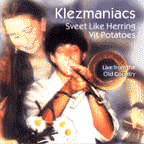 Klezmaniacs (MA) / Sveet like herring vit potatoes, 2001, www.klezmaniacs.org
Klezmaniacs (MA) / Sveet like herring vit potatoes, 2001, www.klezmaniacs.org
The Klezmaniacs began playing as teenagers, at their Temple in Swampscott, north of Boston, MA. For several years they have crowded to KlezKamp, played gigs wherever they could, and in 2000, toured Europe for a couple of weeks. This, their second album, documents that tour and demonstrates a band that has grown, as its members indeed have, from being a high school band, to something much more mature. The album also demonstrates why the band could fairly also be considered a goodwill tour for klezmer: The music is infectious, and the repertoire is well-chosen klezmer standards and Yiddish theatre gems--not just the familiar, but the new and worth knowing--even a delightful Yiddish rendition of "Dnepropetrovosk" and a lively Israeli medley. (I count "I like she" among those that were previously unknown to me, but represent that delightful "Yinglish" that gave us so many great songs and memorable phrases.)
Although the band still has room to grow musically, this album documents that they are well on the way, with good musical ears, the ability to put life even into old chestnuts such as "Oy Tate," and a clear desire to keep playing wonderful music. It also documents a time and an Eastern European tour that were clearly very moving to both band and audience. I look forward to seeing them perform, and to hearing their next outing on CD.
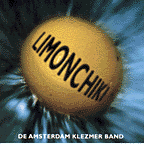 Amsterdam Klezmer Band / Limonchiki, JAM KFW-300, 2001, www.knittingfactory.com
Amsterdam Klezmer Band / Limonchiki, JAM KFW-300, 2001, www.knittingfactory.com
This is an intriguing album. It opens with a couple of relatively stiff, klezmer workhorses. The beat is fiercely strict, as though learned from a simple cheat book. On "De Vurrvreter van sassari," there is a strong "railroad" beat, as though the band listened to Orange Blossom Special just a few too many times (indeed, the clarinet solo on that piece is very much influenced by the aforementioned bluegrass number). Then I find myself listening to something that sounds like Klezmer Rap music in the middle section of "Der Terkishe Yale We Yove Valenstein Nigun", and again on "A chassid in Amsterdam". So, there is more going on here than a sort of retro to the clumsiness of early klezmer revival, but I'm not sure how much or how far. At its best, the band has a lot of pleasant energy, with a nice freneticism to the vocals,as on "Der mame ist gegangen." The instrumental breaks are also excellent and more inventive than the often-rigid rhythm section would lead one to expect. There is some nice improvisation and cross-Europe musical exchange happening in some places that makes this a more interesting album than I heard at first listen. Just what the world needs: An inventive klezmer balkan rap band. This could get really good! (If my Dutch were better, this might rival 2 Live Jews or Gefilte Joe and the Fish.) In the meantime, this may not be a great album, but there is definitely something interesting going on.
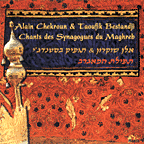 Alain Chekroun & Taouifik Bestandji / Chants des Synagogues du Maghreb, 2000, Magda MDG027, available in the United States from Hatikvah Music (Liner notes in French with Hebrew texts and French translation)
Alain Chekroun & Taouifik Bestandji / Chants des Synagogues du Maghreb, 2000, Magda MDG027, available in the United States from Hatikvah Music (Liner notes in French with Hebrew texts and French translation)
Different from the overpowering voice of Emil Zrihan (solo, and in the Orchestre Andalous), Cantor Alain Chekroun has a warm, personal tenor quite similar, at times, to Loren Sklamberg, of Klezmatics fame. This music, of course, will not be confused with that of the Klezmatics, or with klezmer, at all. Rather, this collection of traditional synagogue music from the Maghreb (Algeria) is an exquisite journey to a time and place unfamiliar to most American listeners. It is a place to which we will return often. Chekroun's voice shines on the a capella "Kol yachiv", and then towers on the more straightforward ensemble-backed "Rahomekha", or the more wandering, almost folky interplay between the orchestra and Chekroun's voice on "Gam ki hamelekh". The small ensemble, led by Taoufik Bestandji, is excellent, and worth hearing in its own right. At the same time, although the melodies are clearly north African, some of these will sound familiar to those familiar with Jewish liturgy (and the words will sound even more familiar). The result is a delightful album which offers compelling proof that this music has been too unknown for too long to Western audiences. This album is a good place to start changing that lack of familiarity. Enjoy.
Mark Levy / Bin ikh mir a shnayderl (I'm a little Tailor), 1999. Available from Tara Music, www.tara.com
Mark Levy has been entertaining audiences for decades. His first albums, back in the late 1970s, were part of the anti-nuclear and progressive folk movement. In recent years he has recorded a variety of Jewish song. On this CD he focuses on Yiddish work songs, showcasing a broad and pleasant Yiddish repertoire and 20 years of audience-pleasing craft. The album doesn't skip familiar songs such as "Mayn ruhe plats" (my resting place) or "A nign" (a variant of "chiri bim bam"), here renewed with a nicely done folk feeling and vigor. But it also includes songs that are new to me, such as the opening, title song, about several workers, none of whom seem to make a living, "Rocking a Stranger's Child", collected by the late Ruth Rubin, which sounds like a variant of "Der Mame ist gegangen", the mixed English-Yiddish, "Say O'Brien," collected by the late Ruth Rubin from an anonymous author in Winnipeg. My only excuse in letting this slip between the cracks for so many years is that we never finished listening to it.
Roy Nathanson & Anthony Coleman / I could've been a drum, 1997. Tzadik TZ 7113, www.tzadik.com
From the opening squeaks and kvetches, gradually developing lines and motifs, the opening "Ija Mia," credited as a traditional Sephardic tune, swaps in and out with repeated and requisite Copernican rumblings and bangings, marrying tradition to a very New York Jewish attitude (I can understand why the band felt obligated to record a second version, later on the CD--an even better one, if possible.) Similar play happens with the more Ashkenazic-sounding (to my ears) "Rumle." From that start, through the closing humor of Nathanson's "Blues," this is the sort of mix that made Tzadik so vital, and if I haven't heard anything quite this good this way this year, I am not embarrassed to catch up on earlier listening to pick up the slack. This is the third outing by this particular trio. It's the one I've had lying around for good listening for a while. The interplay between Nathanson's sax and Coleman's piano, supplemented by Marc Ribot's guitar on some tracks, and likewise, Brad Jones' bass, which is also an interplay involving both of them exploring the fusion between mostly Sephardic traditions and the avant garde, works incredibly well. A sound clip from "Mr. Pig gets a balloon" (an odd Jewish title for an odd not-so-Jewish song), with its humorous play back and forth between the two, is available from the Tzadik site.
Rabson, Mimi / Music, 2002. MM 1089, www.meemzmusic.com
Rabson, former violinist with the Klezmer Conservatory Band, lets loose here on a wide range of tunes ranging in style from jazz-rock onward. As I listen to this CD over and over, in the car and at home, there doesn't seem to be an appropriate way to categorize the album beyond the title, "Music." Although the rhythm section, and occasional cameos by friends, help frame the music, it is Rabson's soaring, lyrical violin, and the ability to conjure moods and styles beyond definition that make this CD such a pleasure. The sweetness of a mellow bluesy number like "Sometimes" are in sharp contrast to the edgy jazz-rock sounds of "Violation" and "Because I can", to the Hendrix-ish, "Amazing Grace" tone that opens Duke Ellington's "Craven" (the only non-Rabson-penned tune here) and the harsh lyricism of "Hormonology" what comes through is imagination and violin and music. Especially music. This one's a keeper. Highly recommended.

